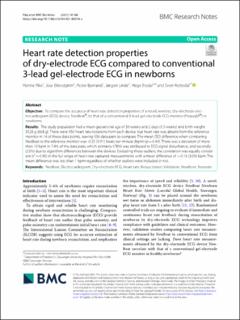| dc.contributor.author | Pike, Hanne | |
| dc.contributor.author | Eilevstjønn, Joar | |
| dc.contributor.author | Bjorland, Peder Aleksander | |
| dc.contributor.author | Linde, Jørgen Erland | |
| dc.contributor.author | Ersdal, Hege | |
| dc.contributor.author | Rettedal, Siren | |
| dc.date.accessioned | 2023-03-09T10:17:25Z | |
| dc.date.available | 2023-03-09T10:17:25Z | |
| dc.date.created | 2021-07-27T17:29:26Z | |
| dc.date.issued | 2021 | |
| dc.identifier.citation | Pike, H., Eilevstjønn, J., Bjorland, P., Linde, J., Ersdal, H., & Rettedal, S. (2021). Heart rate detection properties of dry-electrode ECG compared to conventional 3-lead gel-electrode ECG in newborns. BMC Research Notes, 14(1), 1-5. | en_US |
| dc.identifier.issn | 1756-0500 | |
| dc.identifier.uri | https://hdl.handle.net/11250/3057285 | |
| dc.description.abstract | Objective
To compare the accuracy of heart rate detection properties of a novel, wireless, dry-electrode electrocardiogram (ECG) device, NeoBeat®, to that of a conventional 3-lead gel-electrode ECG monitor (PropaqM®) in newborns.
Results
The study population had a mean gestational age of 39 weeks and 2 days (1.5 weeks) and birth weight 3528 g (668 g). There were 950 heart rate notations from each device, but heart rate was absent from the reference monitor in 14 of these data points, leaving 936 data pairs to compare. The mean (SD) difference when comparing NeoBeat to the reference monitor was -0.25 (9.91) beats per minute (bpm) (p = 0.44). There was a deviation of more than 10 bpm in 7.4% of the data pairs, which primarily (78%) was attributed to ECG signal disturbance, and secondly (22%) due to algorithm differences between the devices. Excluding these outliers, the correlation was equally consistent (r2 = 0.96) in the full range of heart rate captured measurements with a mean difference of − 0.16 (3.09) bpm. The mean difference was less than 1 bpm regardless of whether outliers were included or not. | en_US |
| dc.language.iso | eng | en_US |
| dc.publisher | BMC | en_US |
| dc.rights | Navngivelse 4.0 Internasjonal | * |
| dc.rights.uri | http://creativecommons.org/licenses/by/4.0/deed.no | * |
| dc.title | Heart rate detection properties of dry-electrode ECG compared to conventional 3-lead gel-electrode ECG in newborns | en_US |
| dc.type | Peer reviewed | en_US |
| dc.type | Journal article | en_US |
| dc.description.version | publishedVersion | en_US |
| dc.rights.holder | The authors | en_US |
| dc.subject.nsi | VDP::Medisinske Fag: 700 | en_US |
| dc.source.pagenumber | 1-5 | en_US |
| dc.source.volume | 14 | en_US |
| dc.source.journal | BMC Research Notes | en_US |
| dc.source.issue | 1 | en_US |
| dc.identifier.doi | 10.1186/s13104-021-05576-x | |
| dc.identifier.cristin | 1922823 | |
| cristin.ispublished | true | |
| cristin.fulltext | original | |
| cristin.qualitycode | 1 | |

